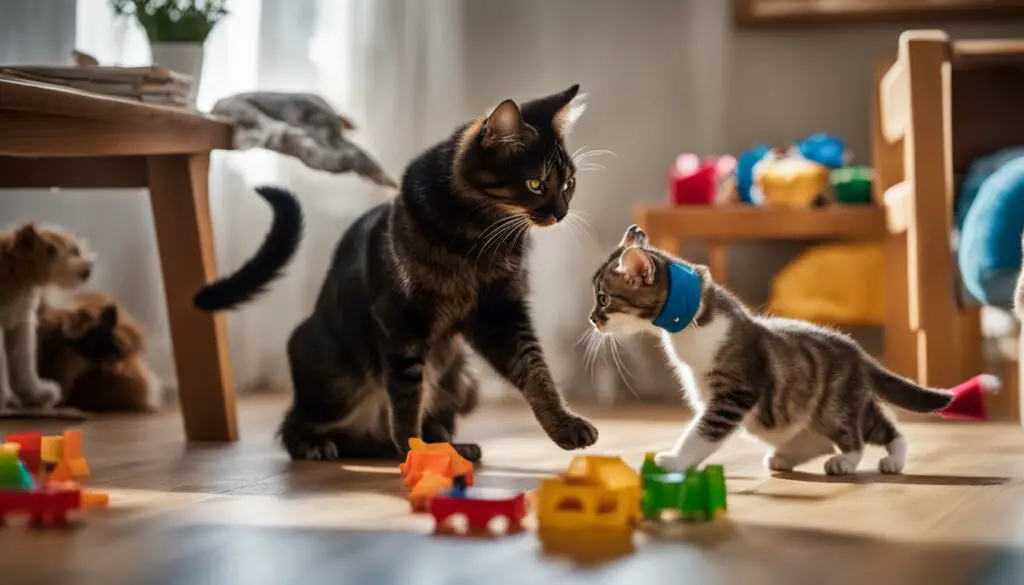It can be quite challenging to determine whether your cat and dog are just playing or if their interactions are turning into an aggressive fight. As a pet owner, understanding their behavior and body language is crucial to ensure the well-being and safety of your pets. By being observant and knowledgeable, you can discern the signs and take appropriate steps to promote a harmonious relationship between your furry friends.
Key Takeaways:
- Understanding the difference between play and aggression is essential for pet owners.
- Observing your cat and dog’s behavior and body language can help determine if they are playing or fighting.
- Play fighting is a normal part of socialization for kittens and puppies.
- Signs of play include a play bow, open mouth, and wagging tail.
- Signs of aggression in dogs and cats include raised hackles, stiff body, and aggressive vocalizations.
Why Do Pets Play Fight?
Play fighting is a natural and essential behavior for pets, particularly in puppies and kittens. Through play fighting, they learn important skills such as communication and self-control. It helps them understand the boundaries of acceptable behavior, such as not biting or scratching too hard. Play fighting also provides exercise and allows them to channel their prey drive in a safe and fun way.
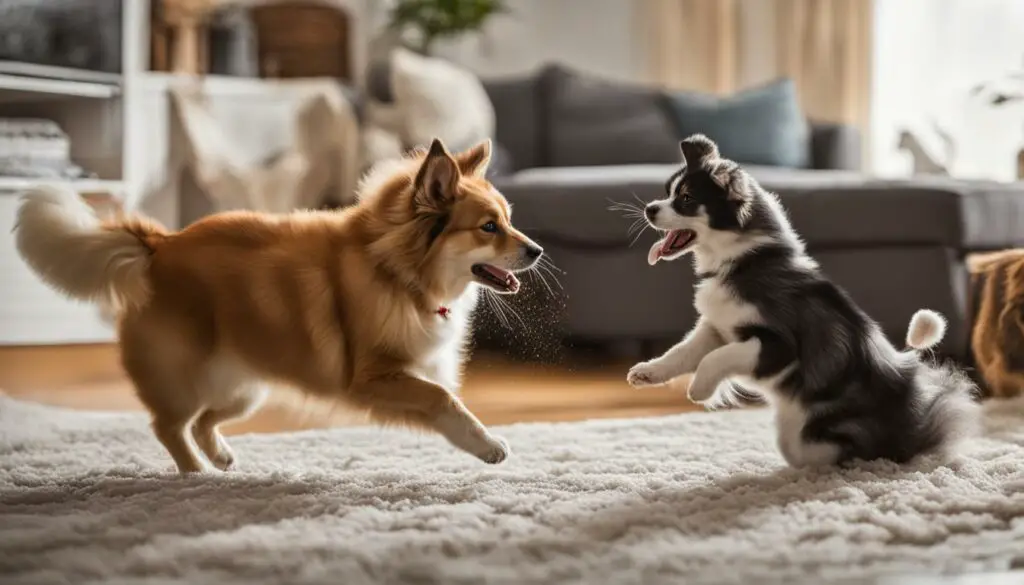
In puppies and kittens, play fighting serves as a socialization tool. It allows them to practice engaging with others, read social cues, and develop their motor skills. When pets play fight, they learn to differentiate between playmates and potential aggressors. It also helps them build trust and establish a hierarchy within their social group. Play fighting is not only physically stimulating but also mentally enriching, as it engages their natural instincts and provides a sense of fulfillment.
Overall, play fighting is an important aspect of pets’ lives. It allows them to learn and grow, both physically and mentally. As pet owners, it is crucial to provide opportunities for play fighting while ensuring their safety and well-being. By understanding the purpose and benefits of play fighting, we can foster a harmonious relationship and create a happy environment for our beloved pets.
Signs of Dogs Playing
Dogs have specific behaviors that indicate they are engaged in play. By understanding these signs, you can differentiate between play and aggression in their interactions. Some common signs of dogs playing include:
- Play Bow: When a dog lowers their front end and raises their rear end, often accompanied by slapping their front legs on the ground.
- Open Mouth: Dogs often have their mouths open, resembling a grin, while they are playing.
- Wagging Tail: A wagging tail is a clear sign of a dog’s playful mood.
In addition to these signs, dogs may exhibit bouncy and relaxed movements, show vulnerability by “falling” and being caught by their playmate, and engage in play biting. Taking turns chasing each other is also a common behavior during play sessions.
Understanding these signs of dogs playing can help you ensure that their interactions are friendly and playful. However, it is important to monitor their behavior closely and intervene if any signs of aggression or discomfort arise.
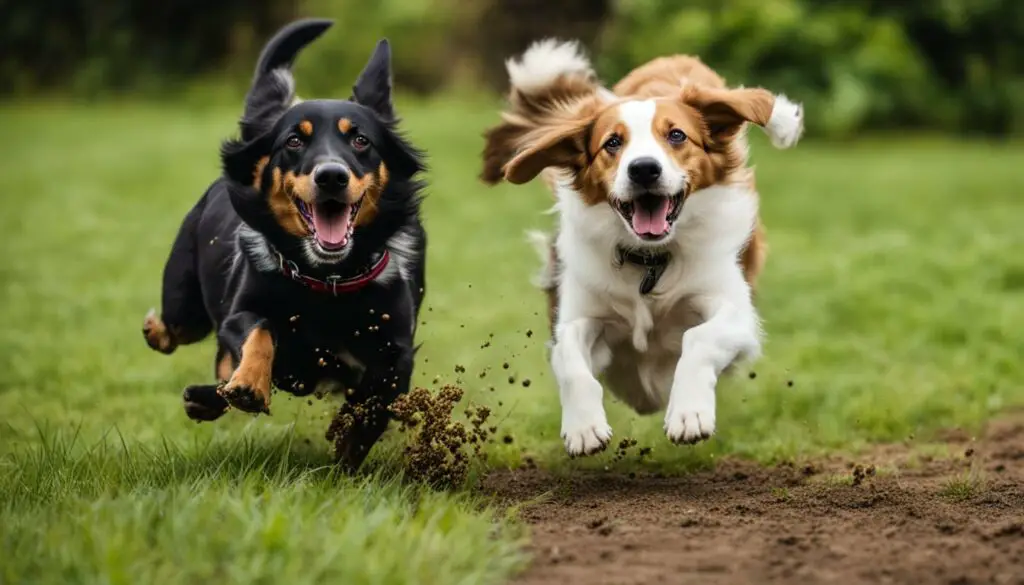
Examples of Dogs Playing
Here are a few examples of dogs playing:
“My dog, Max, often initiates play by performing a play bow and wagging his tail. He loves to chase and be chased by other dogs, and they take turns playfully nipping at each other’s mouths. Their movements are energetic and bouncy, indicating their playful mood.”
When my friend’s dogs play together, they often exhibit a relaxed posture and open mouths, showing their enjoyment. They frequently take turns chasing each other, showing that their interactions are friendly and playful.”
Table: Comparison of Signs of Playing vs. Signs of Fighting in Dogs
| Signs of Playing | Signs of Fighting |
|---|---|
| Play bow | Stiff body |
| Open mouth | Closed mouth |
| Wagging tail | Raised hackles |
| Bouncy and relaxed movements | Short, quick, and strategic movements |
| Taking turns chasing | Aggressive pursuit |
By comparing the signs of playing and fighting in dogs, it becomes clear that certain behaviors can help you determine their intentions. Monitoring their body language and behavior closely is crucial to ensuring a safe and enjoyable play experience for all dogs involved.
Signs of Dogs Fighting
When dogs are engaged in a real fight, there are specific signs that indicate aggression and potential danger. It is important for pet owners to be able to recognize these signs in order to intervene and prevent any harm. Some common signs of dogs fighting include:
- Raised Hackles: Dogs have a fur ridge along their back called hackles. When a dog is agitated or aroused, their hackles may rise, indicating a heightened state of aggression.
- Stiff Body: Dogs in a fight often have a stiff body posture, with their legs and tail held rigidly. This indicates tension and readiness to defend themselves or attack.
- Closed Mouth: In a fight, dogs usually have their mouths closed or tightly clenched. This is a defensive position and can be a warning sign of aggression.
- Curled Lips: When a dog raises its lips, showing its teeth, it is a clear sign of aggression. This is a warning to back off and indicates the dog’s readiness to bite.
These signs, when observed together, indicate that the dogs are not engaged in playful behavior and that a real fight may occur. It is important to intervene promptly, using safe and effective methods to separate the dogs and diffuse the situation.
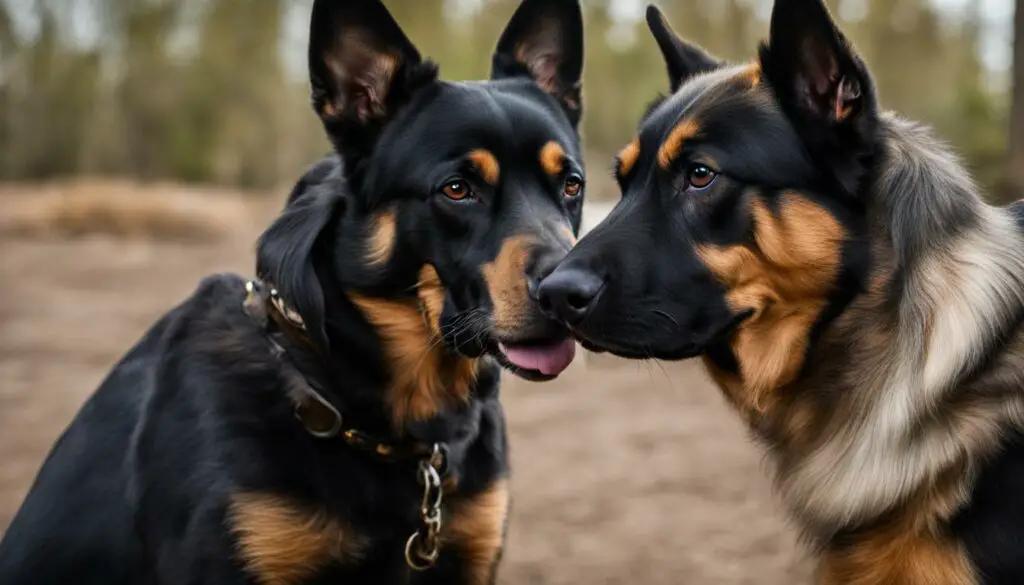
Signs of Cats Playing
When it comes to cats, playtime can be both entertaining and adorable. Understanding the signs of cats playing can help pet owners differentiate between playful behavior and potential aggression. Here are some common signs of cats engaging in playful interactions:
- Play Biting: Cats may gently bite each other during play, but it is usually not aggressive or harmful.
- Retracting Claws: When cats play, they often keep their claws retracted to avoid causing injury to their playmates.
- Taking Turns Chasing Each Other: Cats often engage in chase games, where one cat will chase the other, and then they will switch roles.
These signs indicate that cats are enjoying their playtime and are not exhibiting any signs of aggression. It’s important for pet owners to encourage and provide opportunities for cats to engage in appropriate play, as it helps them exercise, release energy, and strengthen their bond with their feline companions.
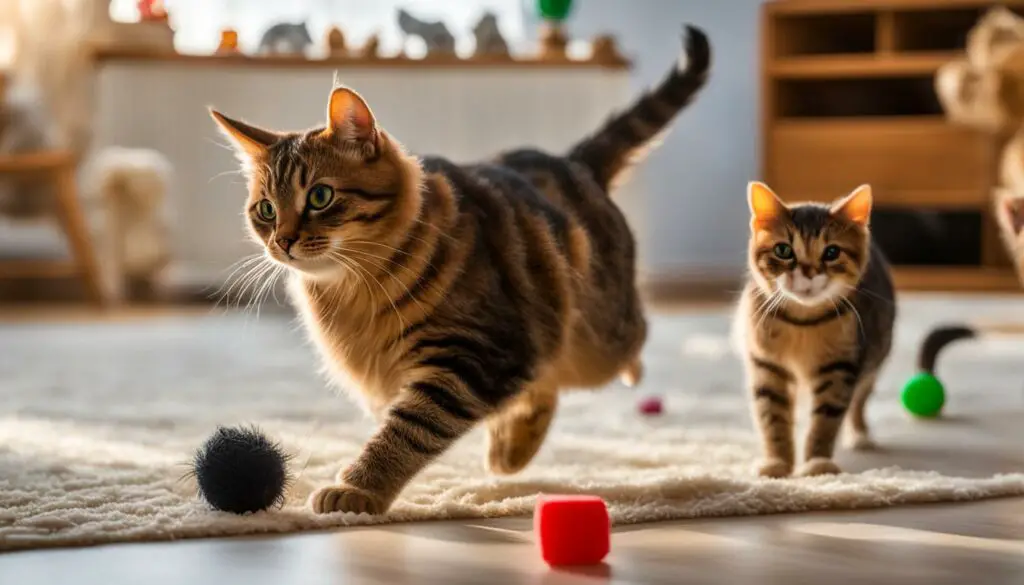
Table: Comparison of Signs of Cats Playing and Fighting
| Signs of Cats Playing | Signs of Cats Fighting | |
|---|---|---|
| Play Biting | Gently biting without aggression | Aggressive biting with intent to harm |
| Retracting Claws | Claws generally kept retracted | Claws extended for attacking |
| Taking Turns Chasing Each Other | Switching roles during chase games | Relentless pursuit and attacking |
Table: Comparison of signs of cats playing and fighting. Cats display certain behaviors during playtime and aggression, which can be differentiated based on their actions and body language.
Signs of Cats Fighting
Cats display specific behaviors when they are fighting. These signs can help pet owners identify when their cats are engaged in aggressive behavior and take appropriate action. Some common signs of cats fighting include:
- Flattened or pinned-back ears
- Puffed-up tail
- Hissing
- Baring teeth
When cats are fighting, they may flatten or pin their ears back against their head. This is a defensive posture that signals aggression. Additionally, a puffed-up tail is a clear sign of a fight. Cats will fluff out their tails to appear larger and more intimidating. Hissing is another telltale sign of aggression in cats. It is a vocalization they make to warn their opponent to back off. Lastly, baring teeth is a clear indicator that a fight is occurring. Cats will show their teeth as a threat and a warning.
“Flattened or pinned-back ears, a puffed-up tail, hissing, and baring teeth are all signs that indicate a cat is engaging in aggressive behavior.”
If you observe your cats displaying any of these signs, it is important to intervene to prevent the fighting from escalating. Provide a distraction such as throwing a soft toy nearby, making a loud noise, or clapping your hands to startle them and redirect their attention. Separating the cats and creating space between them can also help diffuse the situation. Don’t attempt to physically separate them with your hands, as you may get scratched or bitten.
Creating a calm and peaceful environment for your cats is essential to prevent frequent fights. Ensure that each cat has their own territory, including separate food and water bowls, litter boxes, and resting areas. This will help reduce competition and potential triggers for fights. Providing plenty of toys, scratching posts, and interactive playtime can also help alleviate any pent-up energy or frustration that may lead to fights.
| Signs of Cats Fighting | Explanation |
|---|---|
| Flattened or pinned-back ears | A defensive posture indicating aggression |
| Puffed-up tail | Used to appear larger and more intimidating |
| Hissing | A vocal warning to back off |
| Baring teeth | A threat and a clear sign of aggression |
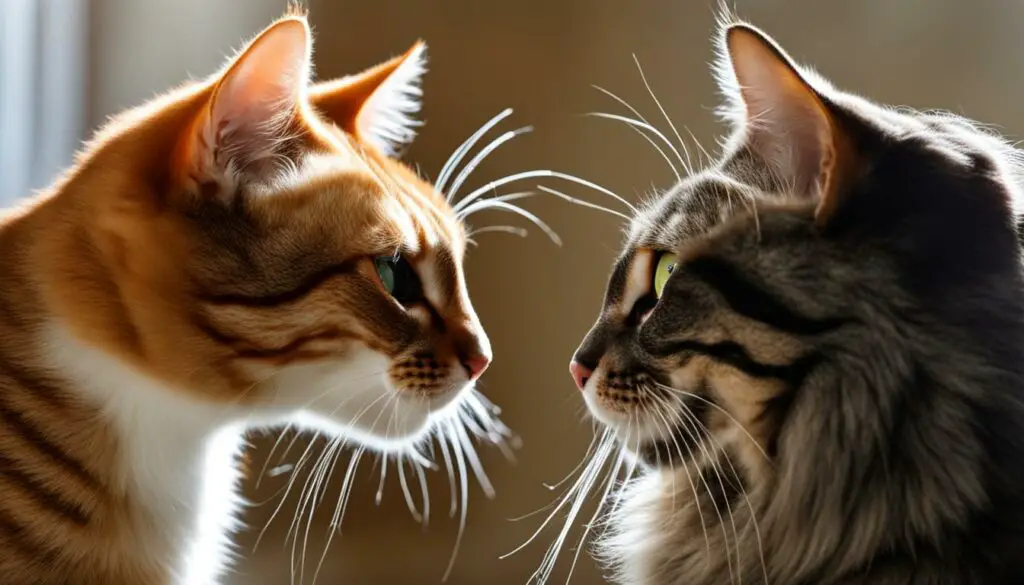
Can Dogs and Cats Play Together?
As a pet owner, you may wonder if it’s possible for dogs and cats to play and coexist peacefully. While the phrase “fighting like cats and dogs” might suggest otherwise, dogs and cats can indeed develop positive relationships and enjoy playful interactions with each other. However, it’s essential to understand the dynamics between these two different species and take appropriate steps to foster compatibility and harmony.
When it comes to dogs and cats playing together, it’s crucial to provide each pet with their own space to retreat to when needed. This allows them to have a sense of security and privacy, which can help prevent tension or conflicts. By giving your pets individual areas, you allow them to establish boundaries and seek solitude when desired.
| Dogs | Cats |
|---|---|
| Can be trained to be cat-friendly | May be more cautious around dogs |
| Some breeds are known to get along well with cats | May need time to warm up to dogs |
| May enjoy engaging in playful behaviors with cats | Can be playful with dogs, especially if they’ve grown up together |
Introducing dogs and cats at a young age can greatly increase the likelihood of positive interactions and a harmonious coexistence. When dogs and cats are raised together as puppies and kittens, they have the opportunity to learn each other’s behaviors and develop a bond that transcends their natural differences. However, even if you have an older dog or cat, it’s still possible to integrate them successfully by following proper socialization techniques and finding pets that are compatible in terms of temperament.
The Benefits of Dogs and Cats Playing Together
- Increased physical activity: Playful interactions between dogs and cats provide much-needed exercise, helping to keep them fit and healthy.
- Emotional enrichment: Playing together can strengthen the bond between dogs and cats, promoting emotional well-being.
- Reduced boredom: Dogs and cats can provide stimulation and entertainment for each other, reducing the likelihood of destructive behavior due to boredom.
By understanding the unique needs and behaviors of both dogs and cats, and by providing them with a safe and enriched environment, you can create a living situation where they can play together and coexist peacefully. With patience, supervision, and proper introductions, dogs and cats can develop positive relationships that bring joy and companionship to your household.

Misinterpreted Body Language
Understanding the body language of our pets is crucial for interpreting their interactions accurately. However, misinterpretations can occur, leading to potential conflicts between cats and dogs. One common misinterpretation involves tail wagging. While dogs wag their tails when they are happy or excited, cats use tail wagging as a warning sign. This miscommunication can lead to cats feeling threatened and potentially lashing out at the dog.
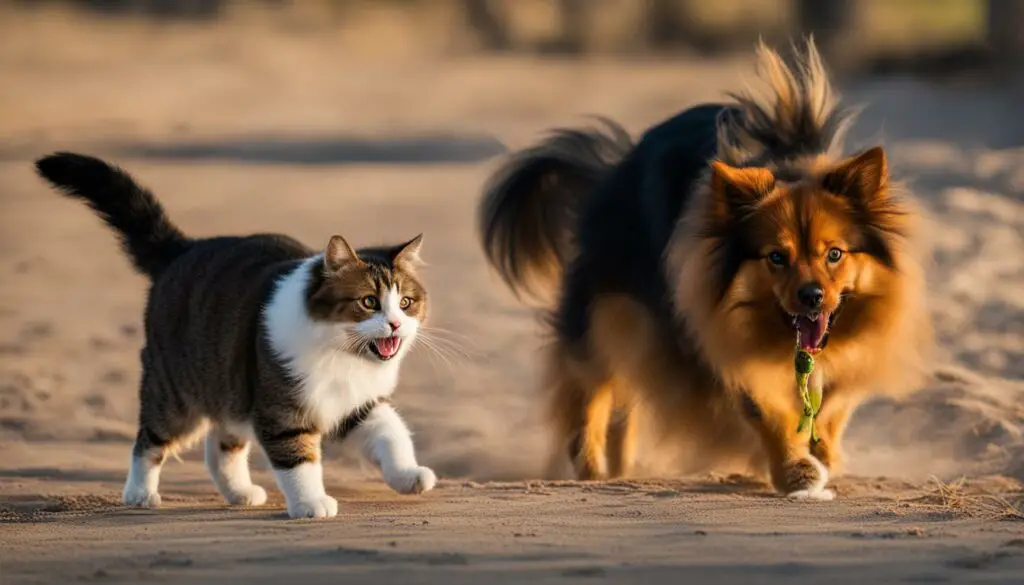
Another area of miscommunication is in the different communication signals used by cats and dogs. For example, dogs’ forward ears indicate aggression, while cats interpret this as interest. Similarly, when soliciting playtime, the body language can be misread. A dog rolling over to show its belly is a submissive gesture, but a cat in the same position may engage in aggressive behavior. These mixed signals can cause confusion and misunderstandings between pets.
It is important for pet owners to familiarize themselves with the specific body language signals of both cats and dogs. Recognizing the differences in tail wagging, ear positions, and solicitation of playtime can help prevent miscommunication and potential conflicts.
By understanding and paying attention to the subtle cues of your pets, you can intervene early and diffuse any misunderstandings. This can help create a safer and more harmonious environment for your cats and dogs to coexist. Remember, clear communication is not just for humans – it is essential for our furry friends too!
Good Signals in Interactions
While cats and dogs have different body language cues, they also share several behaviors that indicate positive interactions. Understanding these signals can help pet owners foster a harmonious relationship between their pets.
“Blinking is a sign of relaxation and friendliness in both species,” says Dr. Smith, a veterinarian at PetCare Clinic. “When your dog or cat blinks at you or another pet, it’s a clear indication that they feel comfortable and at ease.”
Another positive sign is when dogs and cats sleep close to each other or even snuggle together. This behavior shows trust and bonding between the animals. It’s important to provide them with cozy spaces where they can relax and sleep peacefully.
Grooming is also a genuine sign of affection between dogs and cats. When a cat licks a dog or vice versa, it’s their way of showing care and love,” explains Dr. Smith. “This behavior strengthens their bond and promotes a sense of camaraderie.”
Commonalities between Dogs and Cats
In addition to the above behaviors, cats and dogs share some commonalities in their interactions. Both species communicate through blinking, which is a universal display of trust and friendliness. The act of blinking can help ease tensions and establish a positive rapport.
Furthermore, when cats and dogs groom themselves or each other, it not only promotes cleanliness but also serves as a social bonding activity. This mutual grooming helps strengthen their bond and fosters a sense of companionship.
Table
| Good Signals from Interactions | Meaning |
|---|---|
| Blinking | Relaxation and friendliness |
| Sleeping close or snuggling | Trust and bonding |
| Grooming | Affection and camaraderie |
Recognizing and appreciating these positive behaviors in your cat and dog can help you create a happy and peaceful environment for them to coexist. It’s important to give them space, provide opportunities for cozy naps, and allow for social grooming to strengthen their bond. By understanding and nurturing these commonalities, you can promote a harmonious relationship between your furry friends.
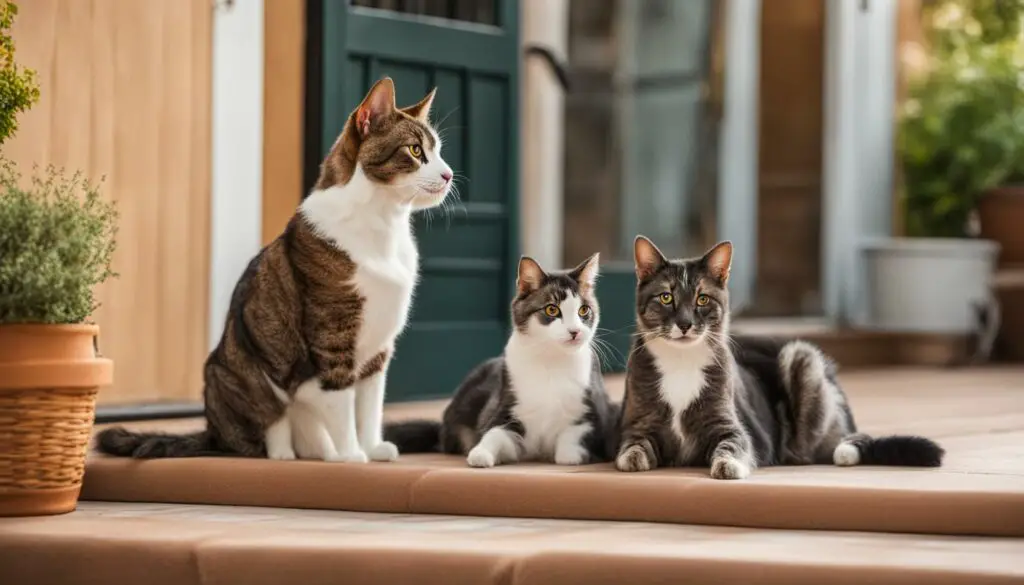
Play or Fight?
When it comes to the interactions between our furry friends, it can sometimes be challenging to distinguish between play and actual aggression. As pet owners, it is crucial to understand the warning signs that indicate a play fight may escalate into a real fight. By recognizing these signs, we can intervene and ensure the safety of our pets.
Warning Signs in Play Fights
During play fights between dogs and cats, there are certain behaviors that may signal the potential for aggression. Barking loudly, abrupt tail twitching, low-pitched growls, hissing, and the use of claws or teeth are all warning signs to watch out for. These behaviors suggest that the play may be turning aggressive and could result in harm to one or both pets. If you observe any of these signs, it is essential to separate the pets and provide a cooling-off period to prevent the situation from escalating further.
Remember, when it comes to play fights, it’s always better to err on the side of caution. Safety should be our top priority, and by being vigilant and proactive, we can ensure a harmonious environment for our pets to enjoy their playtime.
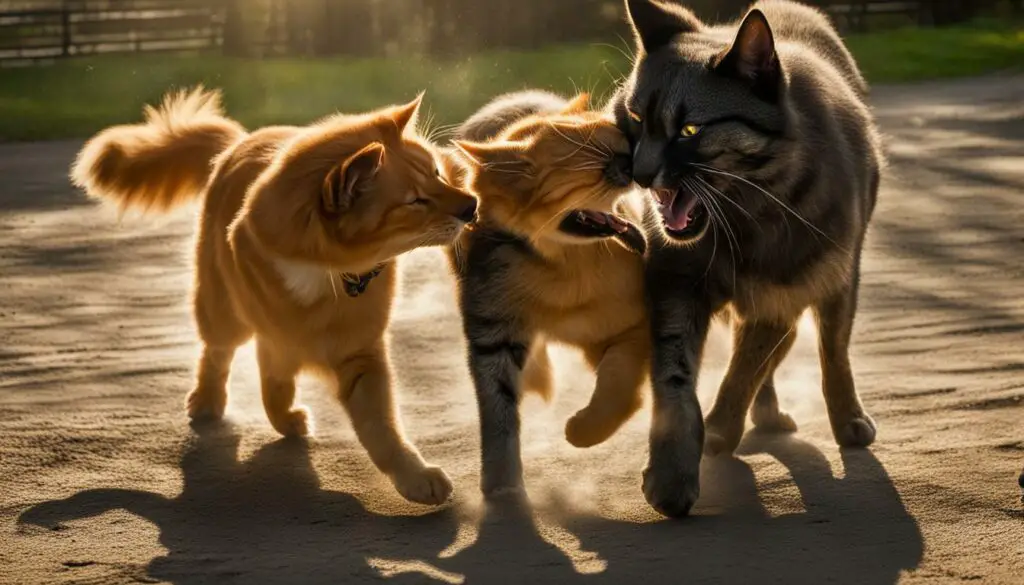
| Warning Signs | Description |
|---|---|
| Loud barking | Indicates heightened arousal and potential aggression. |
| Abrupt tail twitching | Shows increased agitation and potential readiness to strike. |
| Low-pitched growls | Signifies a shift in playfulness to a more serious tone. |
| Hissing | Typically associated with cats and indicates their discomfort or aggression. |
| Use of claws or teeth | Suggests an escalation in aggression and potential harm. |
By being attentive to these warning signs and taking immediate action, we can prevent any harm and ensure that play fights remain safe and enjoyable for our beloved pets.
Integrating Cats and Dogs
Integrating cats and dogs into a harmonious household can be achieved by starting the process at a young age. When cats are introduced to dogs early on, ideally before they reach six months of age, they have a higher likelihood of developing a positive relationship. Similarly, introducing dogs to cats when they are one year or younger allows for smoother integration as they grow up together. This early interaction provides the opportunity for them to learn each other’s behaviors and communication signals, increasing their compatibility in the long run.
However, even if your pets are older, successful integration is still possible. It is important to prioritize socialization and gradually introduce them in a controlled environment. Keep in mind that not all cats and dogs will be compatible, regardless of their age. Factors such as individual personalities and past experiences can influence their willingness to coexist peacefully. When adopting a new pet, consider their history with other animals and seek advice from shelter volunteers to determine if they are cat-friendly or dog-tolerant.
To ensure a smooth integration process, provide each pet with their own designated space where they can retreat when they need privacy or alone time. This helps create a sense of security and prevents territorial conflicts. Additionally, gradually supervised interactions, positive reinforcement, and rewarding calm behavior can foster a sense of trust and promote positive associations between your cat and dog. Patience, consistency, and understanding are key in facilitating a successful integration between cats and dogs, regardless of their age.
| Cat Integration Tips | Dog Integration Tips |
|---|---|
|
|
Key Takeaways:
- Integrating cats and dogs is best initiated at a young age, but older pets can also be successfully integrated with proper socialization and gradual introductions.
- Consider individual personalities and past experiences when assessing compatibility between your pets.
- Designate separate spaces for each pet to ensure privacy and prevent territorial conflicts.
- Gradually introduce your pets in a controlled environment and reward calm behavior to promote positive associations.
- Patience, consistency, and understanding are essential in facilitating a harmonious relationship between cats and dogs.
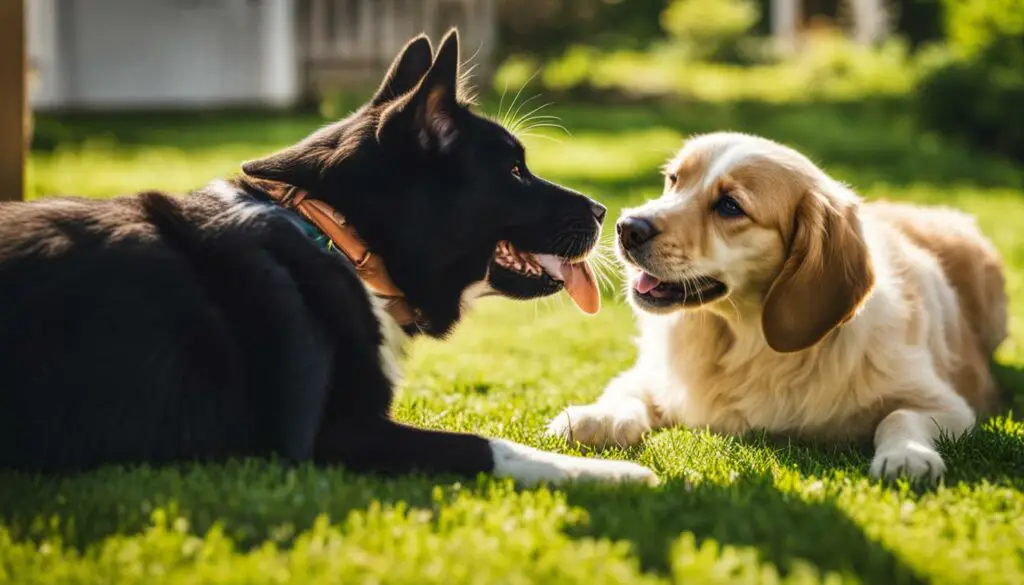
Mixed Signals in Body Language
When it comes to interpreting body language, cats and dogs often send mixed signals that can lead to misunderstandings between them. Understanding these signals is crucial for pet owners to ensure the well-being and harmonious coexistence of their furry friends.
One common area of confusion is tail wagging. Dogs wag their tails as an invitation to play, but for cats, a wagging tail can indicate potential threats. This difference in interpretation can lead to conflicts if not recognized and addressed. Similarly, dogs’ forward ears indicate curiosity, while cats perceive this as aggression. By understanding these contrasting signals, pet owners can intervene early and prevent any potential misunderstandings.
Another key area of miscommunication is in soliciting play. When a dog rolls over and shows its belly, it is a submissive gesture, inviting playfulness. However, if a cat adopts the same posture, it may engage in aggressive behavior. Recognizing these differences in play behavior can help pet owners anticipate and prevent any potential conflicts.
| Signal | Dogs | Cats |
|---|---|---|
| Tail Wagging | Invitation to play | Potential threat |
| Ear Positions | Curiosity | Perceived as aggression |
| Soliciting Play | Rolling over as a submissive gesture | Possible engagement in aggressive behavior |
Recognizing and deciphering these mixed signals is essential for pet owners to foster a positive and safe environment for their pets. By closely observing their body language and understanding their individual communication styles, you can ensure that your cats and dogs have enjoyable and conflict-free interactions.
Conclusion
Understanding the difference between playful interactions and potential fights is essential for pet owners who have both cats and dogs. By observing their behavior and body language, I can intervene when necessary and provide a safe and harmonious environment for my pets. Proper socialization, supervision during play, and providing individual spaces for each pet are key factors in ensuring the successful coexistence of cats and dogs. With patience and understanding, my pets can play well together and bring joy to our household.
FAQ
Are play fights between cats and dogs safe?
Yes, play fights between cats and dogs can be safe and enjoyable as long as they exhibit signs of play, such as soft biting and retracting claws. However, it is important to monitor their behavior and intervene if any signs of aggression arise.
How can I tell if my pets are playing or fighting?
To differentiate between play and aggression, observe their body language. Signs of play include a play bow, open mouth, wagging tail, and taking turns chasing each other. Signs of aggression include raised hackles, a stiff body, a closed mouth, and curled lips.
Can dogs and cats play and coexist peacefully?
Yes, dogs and cats can play and live alongside each other peacefully. It is important to introduce them at a young age and provide individual spaces for them to retreat to. Compatibility can also be assessed when adopting from shelters or rescues.
Why do dogs wag their tails when playing?
Dogs wag their tails when they are happy or excited, and tail wagging can be an invitation to play. However, it is important to note that cats interpret tail wagging as a potential threat, which can lead to misunderstandings.
How can I integrate my cats and dogs successfully?
Integrating cats and dogs can be done successfully by starting at a young age. Cats should be introduced to dogs when they are six months or younger, and dogs should be introduced to cats when they are one year or younger. Proper socialization and finding cat-friendly or dog-tolerant pets are also important.
What are some misunderstandings in body language between dogs and cats?
Dogs and cats have different communication signals that can lead to misunderstandings. For example, dogs’ forward ears indicate interest, while cats interpret them as aggression. Recognizing these mixed signals can help pet owners better understand their pets’ interactions.
How can I prevent potential conflicts between my cats and dogs?
To prevent potential conflicts, provide ample toys and interactive activities for your pets to prevent them from using each other as outlets for their energy. If you suspect your pets are fighting, distract them with toys or make a loud noise as a way to intervene without causing harm.
How can I ensure the safety and well-being of my pets during play fights?
It is important to supervise play fights and intervene when necessary to prevent any escalation into a dangerous fight. Recognize the warning signs of aggression, such as barking loudly, low-pitched growls, and the use of claws or teeth. Provide timeouts and individual spaces for your pets to ensure their safety and well-being.
Can older cats and dogs be integrated successfully?
Yes, even older animals can be integrated successfully with proper socialization and finding cat-friendly or dog-tolerant pets. It may take more time and patience, but with proper introductions and gradual integration, they can learn to coexist peacefully.
How can I understand if my pets are having positive interactions?
Positive interactions between dogs and cats can include blinking, sleeping close together or snuggling, and grooming each other. These behaviors indicate relaxation, trust, and affection between them.
What can I do if my cats and dogs frequently engage in fights?
If your cats and dogs frequently engage in fights, it is important to provide ample toys and interactive activities for them to channel their energy. If the fights persist, consult with a veterinarian or animal behaviorist for further guidance on how to address the issue.

